Docs Remove Snare from Infant in Umabano Group
By Gorilla Doctors Staff on Monday, January 24th, 2011 in Uncategorized.This blog was written by Dr. Jean-Felix
Zirikana is a 4-year-old infant male in Umubano group in Rwanda’s Volacnoes National Park. His mother is Umurimo and his father is the SB Charles. He was reported to be caught in rope snare on left leg on January 2. Trackers were able to cut rope from tree where it was tied, allowing the infant to move freely, but snare still remained tight around his ankle. Elisabeth, Rwanda Development Board’s (RBD) veterinary technician went to check the infant that afternoon, and confirmed the presence of the rope snare on Zirikana’s leg. As always, Gorilla Doctors consulted with the RDB’s head veterinarian Tony Mudakwika and the Chief Park Warden Prosper Uwingeli, along with Elisabeth and trackers. This resulted in the decision to attempt intervention to remove the snare the following morning.
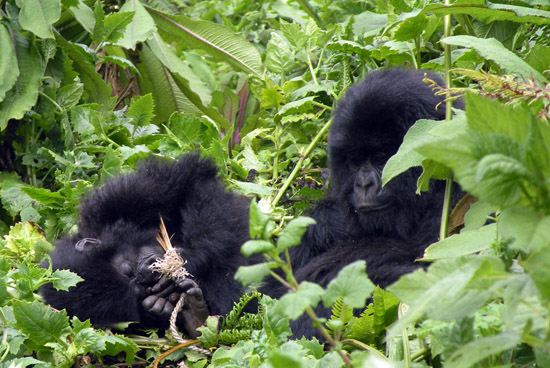 Zirikana looking uncomfortable with his snare.
Zirikana looking uncomfortable with his snare.
Myself and Dr. Jan, along with Elisabeth and Damascene (the RDB Warden for gorilla monitoring) found the group resting in the sun on the morning of intervention. Initially Zirikana was too close to the silverback Charles, and was not in a good position for darting. The whole group was calm, eating and moving slowly so we decided to wait for the perfect shot. Poor Zirikama was looking quite uncomfortable due to the snare. He was not active, not eating and not really moving much.
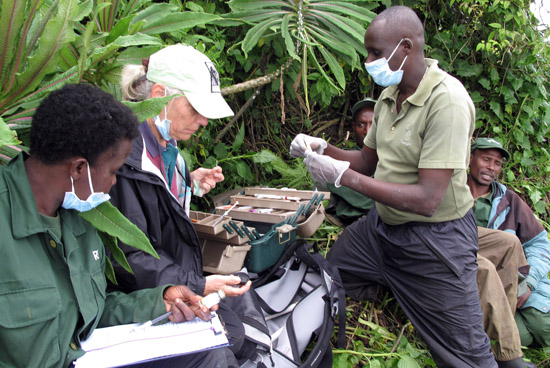 Teams preparing for the intervention after the first assessment.
Teams preparing for the intervention after the first assessment.
We went back to our forest kits, which were left 200 meters from the group with our porters, to prepare the anesthesia dart. When we got back to the group they had moved a bit, but Zirikana was still too near Charles, and still not in a good position for darting. We could only see his face and his abdomen – not good body parts to receive a dart!
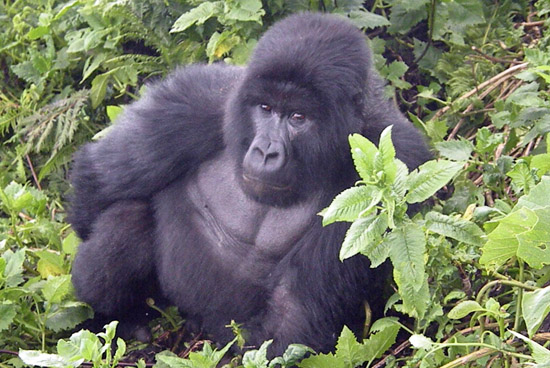 Blackback Bunyenyeri.
Blackback Bunyenyeri.
We waited patiently while the group rested, and when Zirikana finally sat up we moved to a place just above Charles. We finally had a good opportunity to dart Zirikana, who was presenting his back to us. I took a successful shot. Zirikana did not scream but was surprised – he stared at us, then slowly moved to join his mother. Charles and others gorilla suspected something, but did not charge or appear upset. We waited at a distance for Zirikana to go to sleep.
Within 8 minutes, Zirikana was fully anesthetized, lying next to his mother with Charles not far away. We had to get to him. Trackers, porters and vets made noise and moved toward Zirikana, the usual method used to move the group away from an anesthetized gorilla. The group then became very disturbed. There was screaming and running, and Charles grabbed Zirikana by the arm, dragging the sleeping gorilla about 5 meters. He finally dropped him, and moved on. That was our chance to move in to evaluate Zirikana. Experienced trackers surrounded us to keep us safe. Charles began charging to try to help his son, but was stopped by trackers making noise and hitting the ground with sticks.
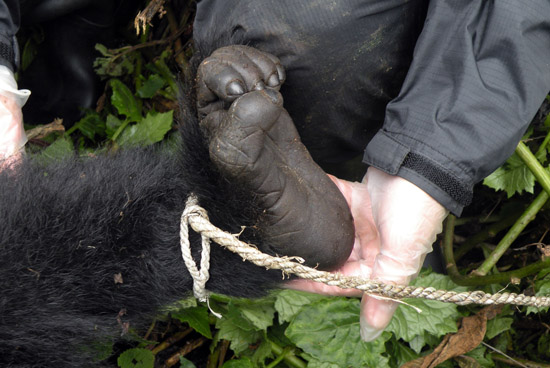 The snare before it is removed.
The snare before it is removed.
The rope snare was quickly removed. Zirikana’s leg was not swollen but that foot was cold. We got there just in time. Zirikana remained stable throughout the procedure, and the Gorilla Doctors conducted a complete physical examination, taking blood and viral swabs and measuring him so that we could learn as much about his health as possible.
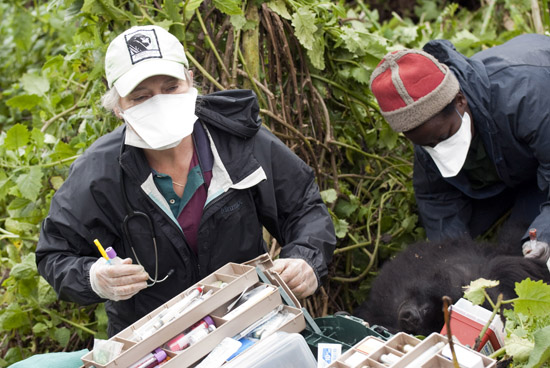 Dr. Jan and Elizabeth prepare to take blood samples from Zirikana.
Dr. Jan and Elizabeth prepare to take blood samples from Zirikana.
Bunyenyeri, the blackback, came close to us of us observing the procedure. He was very interested in his little brother’s safety!
Finally, after 40 minutes, it was time to give Zirikana the reversal drug. Then we moved 20 meters away from him to watch. Bunyenyeri approached first, followed by Charles, who gently examined Zirikana’s left leg and checked where the snare was. Charles then sat next to the groggy Zirikana, keeping himself between us and Zirikana. A good dad. When Zirikana was more stable on his feet, Charles followed close behind him, gently nudging him to move toward his mother. Once Zirikana was with his mother, Charles sat again, and watched us for 10 minutes before we decided to leave the group.
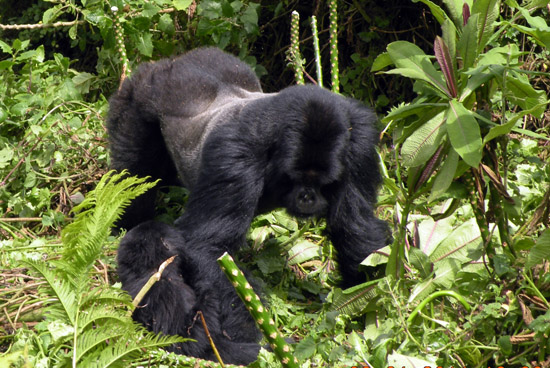 Charles checks on his son after the intervention.
Charles checks on his son after the intervention.
It was a successful intervention!!!! But our work was not finished yet. We brought the field kit and samples back to our laboratory, and myself and Jan went directly to the lab to process the blood, fecal and swabs. These samples will give us more information about the health of Zirikana, and will be included in our bio bank which MGVP and researchers from around the world can examine to learn more about gorilla health.
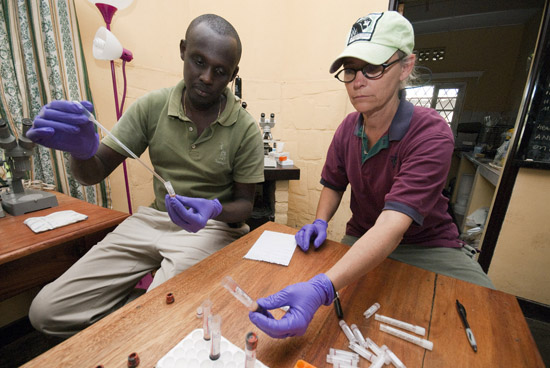 Drs. Jean Felix and Jan process samples in the lab.
Drs. Jean Felix and Jan process samples in the lab.
We finished at 5 pm, tired but happy. We had a long day and good journey, and were happy that we helped this little gorilla.
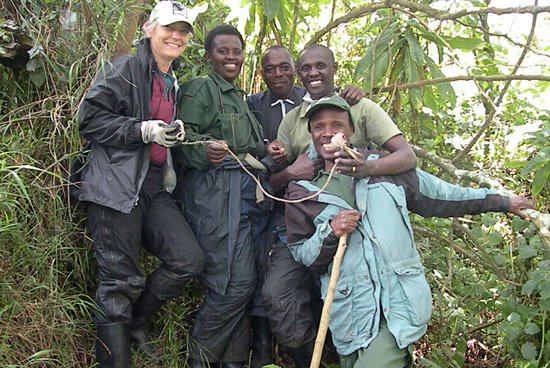 Success!
Success!
Here is the video of our intervention:


 Donate
Donate